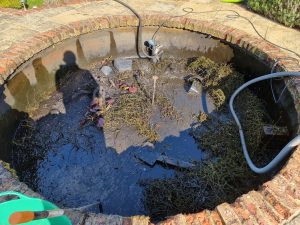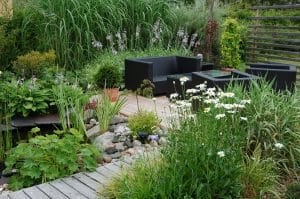How to Clean a Fish Pond Without Harming Your Fish
Maintaining a healthy fish pond is crucial for preserving the ecosystem and ensuring your fish thrive. However, cleaning a fish pond involves more than just removing debris; it requires balancing the needs of your fish, beneficial bacteria, pond plants, and the overall health of the pond water. In this blog, we will guide you on how to clean your pond without harming its delicate ecosystem.
Why Pond Maintenance is Essential for Your Fish
Pond maintenance is vital for the health of your fish and overall pond ecosystem. The balance between clear pond water, beneficial bacteria, and healthy plants ensures a thriving environment for fish. Poor pond maintenance can lead to an overgrowth of algae, unbalanced oxygen levels, and harmful water chemistry, which can negatively affect your fish.
Understanding the natural balance of your pond is essential before cleaning. Beneficial bacteria help break down waste and toxins, while pond plants oxygenate the water and provide shelter for fish. Without this balance, your fish may become stressed or even unhealthy. Cleaning your pond without disrupting this balance is key.
Aqua Pond Ltd. offers expert pond cleaning services to help you preserve your pond’s ecosystem while keeping your fish safe. Contact Aqua Pond Ltd. for professional pond maintenance and cleaning services tailored to your needs.
Preparing Your Pond for Cleaning: The Essential Steps Before You Start
Before cleaning your fish pond, it’s crucial to prepare the pond and its inhabitants. Taking the necessary precautions will ensure that your fish remain safe, and the pond’s ecosystem stays intact.
Assessing the Pond’s Current Condition
- Check Water Clarity: Begin by evaluating the clarity of the pond water. If it’s cloudy, you may need to test the water for imbalances like pH or ammonia levels.
- Identify Problem Areas: Look for excess algae growth, floating debris, or any areas where water is stagnant, which can be harmful to fish.
- Assess Pond Plants: Healthy pond plants help maintain oxygen levels and improve water quality. Examine the plants to ensure they are thriving and not contributing to excess debris.
Removing Fish Safely
- Use Fish-Safe Nets: Relocate your fish using a soft, fish-safe net to prevent stress and injury. Place them in a temporary holding tank with water from the pond to minimise the shock of moving them.
- Keep Fish Out Temporarily: It’s essential to allow the pond to settle after cleaning. Keep the fish out for at least a few hours, or longer if major cleaning is necessary, until the water conditions are stable.
Gathering the Right Tools
- Pond Vacuums: Use a pond vacuum to remove silt, debris, and algae from the pond bottom without disturbing the beneficial bacteria.
- Algae Scrapers: These specialised tools help remove stubborn algae from surfaces without damaging pond plants or harming the fish.
- Fish-Safe Chemicals: If necessary, use gentle, fish-safe treatments to address algae growth or balance pond water chemistry.
Cleaning the Pond: Step-by-Step Process
Now that your pond is prepared, it’s time to clean it. Follow these steps to ensure you maintain the health of your pond and fish.
- Remove Excess Debris and Algae
Start by removing any floating debris and large algae patches from the pond. Use a net or algae scraper to gently remove algae from the surface and the sides of rocks or ornaments.
- Drain the Pond (If Necessary)
If the pond is heavily contaminated with silt or debris, you may need to drain part of the pond. However, it’s important not to completely empty the pond, as it can harm the beneficial bacteria and plants. Leave enough water to support the bacteria and oxygen levels.
- Clean Pond Equipment
Thoroughly clean the filters, pumps, and UV clarifiers to ensure they are working efficiently. These tools are vital in maintaining clear water and proper oxygen levels in your pond.
- Reintroduce Beneficial Bacteria
After cleaning, treat the pond water with a dose of beneficial bacteria to help restore balance and prevent harmful algae growth. Beneficial bacteria break down organic waste and contribute to overall water quality.
Maintaining Pond Health After Cleaning
Once your pond is clean, ongoing pond maintenance is crucial to prevent the buildup of waste, algae, and debris. Regular checks of water clarity, pH levels, and oxygen levels will help maintain a balanced ecosystem. Pond plants should be pruned regularly, and pond filters need routine cleaning to ensure efficient filtration.
By maintaining oxygen levels and addressing algae growth promptly, you can prevent many common pond problems. Regular maintenance will also keep the fish healthy and stress-free.
Step-by-Step Guide to Cleaning Your Fish Pond Without Causing Harm
Cleaning your fish pond requires a careful, measured approach to ensure that you do not disturb the delicate balance of the ecosystem. This section covers effective sludge removal strategies and eco-friendly solutions that are safe for your fish.
Step 1: Clear the Pond’s Surface and Remove Visible Debris
Begin by removing any leaves, twigs, and other floating debris from the pond’s surface. This not only improves the aesthetic appeal but also prevents decay that can lead to an unhealthy buildup of organic matter. Use a pond skimmer or a net designed for aquatic use, and work slowly to avoid causing distress to your fish. If your pond has a pond liner, take extra care around its edges to prevent damage.
Step 2: Clean Pond Filters and Pumps
Your pond’s filter system plays a crucial role in maintaining water quality. Over time, filters accumulate dirt and debris, reducing their efficiency. Disconnect your equipment and gently clean the pond filter by rinsing it with pond water rather than tap water, which may contain chemicals harmful to the beneficial bacteria. Clean any pumps associated with the system as well. This step is essential not only for immediate clarity but also for preserving the natural balance of your pond ecosystem.
Step 3: Dealing with Algae Growth
Excessive algae can be a common challenge. While algae are a natural part of a pond ecosystem, an overgrowth can lead to imbalances and water quality issues. Begin by manually scrubbing areas with visible pond algae. For more severe cases, consider eco-friendly methods to remove algae without harming your fish. One natural solution is to use barley straw, which, when added to the pond, releases compounds that inhibit algae growth as it slowly decomposes. The goal is to let your pond clear naturally without the need for harsh chemicals.
Step 4: Clean the Pond’s Bottom and Rocks
Sediment and sludge accumulate over time at the bottom of your pond, creating a breeding ground for bacteria and potentially affecting water quality. Use a pond vacuum or a gentle siphoning technique to remove the sludge from the bottom. Carefully clean any rocks and submerged surfaces where dirt might settle. This process not only helps in maintaining clear water but also promotes healthy pond wildlife, ensuring that beneficial organisms can thrive.
Post-Cleaning Care and Ongoing Pond Maintenance: Ensuring Long-Term Fish Health
After the intensive cleaning process, maintaining a healthy pond requires ongoing care and attention. Regular maintenance and careful monitoring will keep your aquatic ecosystem in balance and your fish stress-free.
Reintroducing Fish Safely
Once your pond is clean, it’s time to reintroduce your fish. This step is critical, as sudden changes in their environment can lead to stress or shock.
Best Practices for Acclimating Fish
- Gradual Reintroduction: When reintroducing your fish, begin by placing them in a container with water from the cleaned pond. Gradually mix in the pond water with the water they were temporarily held in. This helps them adjust to any changes in the water temperature and chemistry.
- Monitoring Behavior: Carefully observe your fish as they re-enter the pond. Look for any signs of distress such as erratic swimming or lethargy. If any issues arise, it may be necessary to pause further reintroduction and reassess the water quality.
Taking these careful steps will ensure that your fish adjust smoothly back into their environment.
Restoring Water Quality
Water quality is paramount to the health of your pond’s ecosystem. After cleaning, it’s essential to verify that the water chemistry is balanced.
Checking Water Chemistry
- pH Levels: Test your pond’s pH to ensure it is within a range that is safe for fish and beneficial bacteria. An imbalance can lead to stress and disease in your aquatic life.
- Ammonia and Nitrate Levels: Regularly check for ammonia and nitrate levels, as these can indicate decomposition or overfeeding. Keeping these in check is vital for a healthy environment.
- Oxygen Levels: Ensure that there is enough dissolved oxygen in the water to support fish respiration and overall pond health.
Adding Water Treatments
If tests indicate an imbalance, consider adding water treatments or conditioners to restore equilibrium. Using natural and eco-friendly products will help maintain a sustainable ecosystem. Proper treatment not only improves water clarity but also boosts the overall resilience of the pond.
Implementing Regular Maintenance Routines
Long-term success lies in regular, proactive maintenance. Establishing a routine not only prevents future issues but also ensures that your pond remains a haven for aquatic life.
Maintenance Schedule
- Weekly Inspections: Spend a little time each week checking the pond for any signs of debris accumulation or algae growth.
- Monthly Cleaning: Perform a more thorough cleaning once a month, including a quick rinse of the pond filter and clearing visible debris.
- Seasonal Adjustments: Seasonal changes, especially in a winter pond, can bring new challenges. Adapt your cleaning schedule to account for changes in weather, water levels, and fish activity.
Caring for Pond Plants
Pond plants are an essential part of the ecosystem. They provide oxygen, shelter for fish, and help in nutrient cycling. Regularly trim and remove any dead or decaying plant matter to prevent it from fouling the water. Healthy plant life also competes with algae for nutrients, thus contributing to a balanced pond environment.
Monitoring Fish and Pond Wildlife
Regular observation is key to ensuring the continued health of your pond. Keep an eye on fish behavior and look out for changes in activity or appearance that could signal stress or illness. This proactive approach can help you catch potential issues before they become severe. Also, ensure that other elements of pond wildlife—such as amphibians and beneficial insects—are thriving, as they play crucial roles in the ecosystem.
Conclusion
Maintaining a clean fish pond is key to a thriving aquatic ecosystem. By following our guide, you can ensure a balanced habitat that keeps your fish healthy and water clear. For those ready to elevate their pond care, consider the expert services of Aqua Pond Ltd. With over 30 years of experience in pond cleaning, maintenance, repair, and construction in Bedfordshire and surrounding areas, they are the trusted professionals to help you achieve the perfect water feature.
Aqua Pond Ltd. specialises in custom water features including waterfalls, fountains, and aquatic gardens, using high-quality Evolution Aqua Pond products. Their comprehensive services cover everything from debris removal and algae control to pond filter upkeep and liner replacement.
Transform your pond into a stunning, balanced ecosystem today. Call Aqua Pond Ltd. at 01525 552150, email info@aquapond.co.uk, or visit their website and fill out the contact form for inquiries. Take the next step in pond perfection and enjoy a vibrant, healthy aquatic environment!



